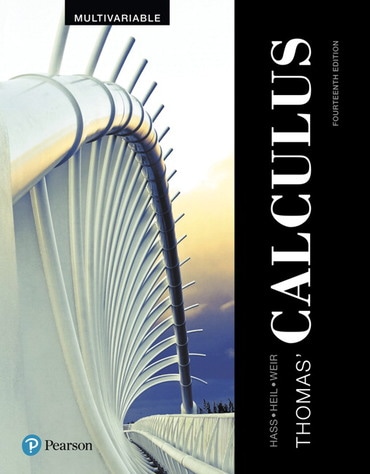Switch content of the page by the Role togglethe content would be changed according to the role

Thomas' Calculus, 14th edition
Published by Pearson (January 1, 2017) © 2018
- Joel R. Hass University of California, Davis
- Christopher E. Heil Georgia Institute of Technology
- Maurice D. Weir Naval Postgraduate School
$255.99
Price Reduced From: $319.99
Details
- A print edition
Title overview
Through its balance of clear and intuitive explanations, current applications, and generalized concepts, Thomas' Calculus helps you reach a level of mathematical proficiency and maturity and provides support where needed. This revision introduces new co-author Christopher Heil.
Table of contents
Table of Contents
- Functions
- 1.1 Functions and Their Graphs
- 1.2 Combining Functions; Shifting and Scaling Graphs
- 1.3 Trigonometric Functions
- 1.4 Graphing with Software
- Limits and Continuity
- 2.1 Rates of Change and Tangent Lines to Curves
- 2.2 Limit of a Function and Limit Laws
- 2.3 The Precise Definition of a Limit
- 2.4 One-Sided Limits
- 2.5 Continuity
- 2.6 Limits Involving Infinity; Asymptotes of Graphs
- Derivatives
- 3.1 Tangent Lines and the Derivative at a Point
- 3.2 The Derivative as a Function
- 3.3 Differentiation Rules
- 3.4 The Derivative as a Rate of Change
- 3.5 Derivatives of Trigonometric Functions
- 3.6 The Chain Rule
- 3.7 Implicit Differentiation
- 3.8 Related Rates
- 3.9 Linearization and Differentials
- Applications of Derivatives
- 4.1 Extreme Values of Functions on Closed Intervals
- 4.2 The Mean Value Theorem
- 4.3 Monotonic Functions and the First Derivative Test
- 4.4 Concavity and Curve Sketching
- 4.5 Applied Optimization
- 4.6 Newton’S Method
- 4.7 Antiderivatives
- Integrals
- 5.1 Area and Estimating with Finite Sums
- 5.2 Sigma Notation and Limits of Finite Sums
- 5.3 The Definite Integral
- 5.4 The Fundamental Theorem of Calculus
- 5.5 Indefinite Integrals and the Substitution Method
- 5.6 Definite Integral Substitutions and the Area Between Curves
- Applications of Definite Integrals
- 6.1 Volumes Using Cross-Sections
- 6.2 Volumes Using Cylindrical Shells
- 6.3 Arc Length
- 6.4 Areas of Surfaces of Revolution
- 6.5 Work and Fluid Forces
- 6.6 Moments and Centers of Mass
- Transcendental Functions
- 7.1 Inverse Functions and Their Derivatives
- 7.2 Natural Logarithms
- 7.3 Exponential Functions
- 7.4 Exponential Change and Separable Differential Equations
- 7.5 Indeterminate Forms and L’Hôpital's Rule
- 7.6 Inverse Trigonometric Functions
- 7.7 Hyperbolic Functions
- 7.8 Relative Rates of Growth
- Techniques of Integration
- 8.1 Using Basic Integration Formulas
- 8.2 Integration by Parts
- 8.3 Trigonometric Integrals
- 8.4 Trigonometric Substitutions
- 8.5 Integration of Rational Functions by Partial Fractions
- 8.6 Integral Tables and Computer Algebra Systems
- 8.7 Numerical Integration
- 8.8 Improper Integrals
- 8.9 Probability
- First-Order Differential Equations
- 9.1 Solutions, Slope Fields, and Euler’s Method
- 9.2 First-Order Linear Equations
- 9.3 Applications
- 9.4 Graphical Solutions of Autonomous Equations
- 9.5 Systems of Equations and Phase Planes
- Infinite Sequences and Series
- 10.1 Sequences
- 10.2 Infinite Series
- 10.3 The Integral Test
- 10.4 Comparison Tests
- 10.5 Absolute Convergence; The Ratio and Root Tests
- 10.6 Alternating Series and Conditional Convergence
- 10.7 Power Series
- 10.8 Taylor and Maclaurin Series
- 10.9 Convergence of Taylor Series
- 10.10 Applications of Taylor Series
- Parametric Equations and Polar Coordinates
- 11.1 Parametrizations of Plane Curves
- 11.2 Calculus with Parametric Curves
- 11.3 Polar Coordinates
- 11.4 Graphing Polar Coordinate Equations
- 11.5 Areas and Lengths in Polar Coordinates
- 11.6 Conic Sections
- 11.7 Conics in Polar Coordinates
- Vectors and the Geometry of Space
- 12.1 Three-Dimensional Coordinate Systems
- 12.2 Vectors
- 12.3 The Dot Product
- 12.4 The Cross Product
- 12.5 Lines and Planes in Space
- 12.6 Cylinders and Quadric Surfaces
- Vector-Valued Functions and Motion in Space
- 13.1 Curves in Space and Their Tangents
- 13.2 Integrals of Vector Functions; Projectile Motion
- 13.3 Arc Length in Space
- 13.4 Curvature and Normal Vectors of a Curve
- 13.5 Tangential and Normal Components of Acceleration
- 13.6 Velocity and Acceleration in Polar Coordinates
- Partial Derivatives
- 14.1 Functions of Several Variables
- 14.2 Limits and Continuity in Higher Dimensions
- 14.3 Partial Derivatives
- 14.4 The Chain Rule
- 14.5 Directional Derivatives and Gradient Vectors
- 14.6 Tangent Planes and Differentials
- 14.7 Extreme Values and Saddle Points
- 14.8 Lagrange Multipliers
- 14.9 Taylor’s Formula for Two Variables
- 14.10 Partial Derivatives with Constrained Variables
- Multiple Integrals
- 15.1 Double and Iterated Integrals over Rectangles
- 15.2 Double Integrals over General Regions
- 15.3 Area by Double Integration
- 15.4 Double Integrals in Polar Form
- 15.5 Triple Integrals in Rectangular Coordinates
- 15.6 Applications
- 15.7 Triple Integrals in Cylindrical and Spherical Coordinates
- 15.8 Substitutions in Multiple Integrals
- Integrals and Vector Fields
- 16.1 Line Integrals of Scalar Functions
- 16.2 Vector Fields and Line Integrals: Work, Circulation, and Flux
- 16.3 Path Independence, Conservative Fields, and Potential Functions
- 16.4 Green’s Theorem in the Plane
- 16.5 Surfaces and Area
- 16.6 Surface Integrals
- 16.7 Stokes' Theorem
- 16.8 The Divergence Theorem and a Unified Theory
- Second-Order Differential Equations (Online at www.goo.gl/MgDXPY)
- 17.1 Second-Order Linear Equations
- 17.2 Nonhomogeneous Linear Equations
- 17.3 Applications
- 17.4 Euler Equations
- 17.5 Power-Series Solutions
Appendices
- Real Numbers and the Real Line
- Mathematical Induction
- Lines, Circles, and Parabolas
- Proofs of Limit Theorems
- Commonly Occurring Limits
- Theory of the Real Numbers
- Complex Numbers
- The Distributive Law for Vector Cross Products
- The Mixed Derivative Theorem and the Increment Theorem
